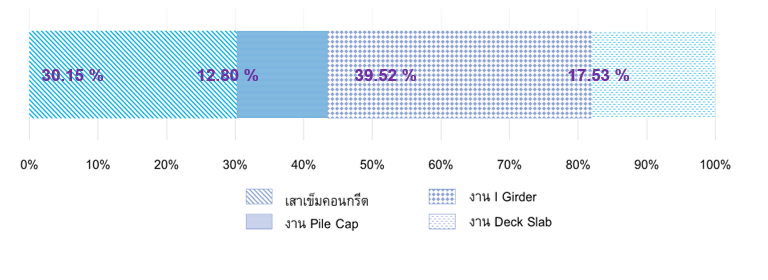Lifecycle Assessment of Greenhouse Gas Emission Railway Concrete Bridge in Thailand
Main Article Content
Abstract
This study aims to study the evaluation method of Assessment greenhouse gas emissions and estimate greenhouse gas emissions in railway bridge construction. This study is to study the railway construction project of bangkhem station to Khao Yoi station railway. The calculation of greenhouse gas emissions is the main task in the order of category and quantity such as precast concrete pile, foundation work (Pile Cap), beam work (I girder), reinforced concrete deck slab according to the research scope, including the production of materials (Candle to Gate: A1 – A3) transportation of material (transport to site: A4) and construction process (Gate to Gate: A5) The results show that in the data analysis of the greenhouse gas emissions in the production process of materials are 544,397,273.39 kgco2e. transportation of material greenhouse gas emission, 811,656.65 kgco2e.During construction, it was found that the amount of gas released during construction was 661,878.52 kgco2e. Production of materials, the highest emission is 97.36%, which is a ready mixed concrete. The largest greenhouse gas emissions are 21,478,768.43 kgco2e from the precast concrete I Girder and 16,845,427.32 kgco2e from the precast concrete pile. In construction projects materials are widely used in a large project. Therefore, in the structural design, the selection of materials and construction methods should be considered. The results show that in the production process, the use of most concrete and reinforcement leads to greenhouse gas emissions. The choice of construction method will affect the transportation and construction site. In concrete engineering, there is quite a lot of transportation than in concrete engineering. In addition, concrete construction produces less greenhouse gas emissions.
Article Details

This work is licensed under a Creative Commons Attribution-NonCommercial-NoDerivatives 4.0 International License.
เนื้อหาและข่อมูลในบทความที่ลงตีพิมพ์ในวารสารวิชาการ เทคโนโลยี พลังงาน และสิ่งแวดล้อม บัณฑิตวิทยาลัย วิทยาลัยเทคโนโลยีสยาม ถือเป็นข้อคิดเห็นและความรับผิดชอบของผู้เขียนบทความโดยตรง ซึ่งกองบรรณาธิการวารสารไม่จำเป็นต้องเห็นด้วย หรือว่าร่วมรับผิดชอบใด ๆ
บทความ ข้อมูล เนื้อหา รูปภาพ ฯลฯ ที่ได้รับการตีพิมพ์ในวารสารวิชาการ เทคโนโลยี พลังงาน และสิ่งแวดล้อม บัณฑิตวิทยาลัย วิทยาลัยเทคโนโลยีสยาม ถือเป็นลิขสิทธิ์ของวารสารวิชาการ เทคโนโลยี พลังงาน และสิ่งแวดล้อม บัณฑิตวิทยาลัย วิทยาลัยเทคโนโลยีสยาม หากบุคคล หรือหน่วยงานใดต้องการนำทั้งหมด หรือส่วนหนึ่งส่วนใดไปเผยแพร่ต่อ หรือเพื่อกระทำการใด ๆ จะต้องได้รับอนุญาต เป็นลายลักษณ์อักษรจากวารสารวิชาการ เทคโนโลยี พลังงาน และสิ่งแวดล้อม บัณฑิตวิทยาลัย วิทยาลัยเทคโนโลยีสยาม เท่านั้น
References
Thailand Greenhouse Gas Management Organization (Public Organization). Low Carbon Society Guidebook. Low Carbon Society Guidebook. First Edition, Laksi District, Bangkok: Taweewat Printing Co., Ltd.;2015.
GABC Global Alliance for Buildings and Construction. International Energy Agency and the United Nations Environment Program: 2019 Global Status Report for Buildings and Construction: Towards a Zero-Emission, Efficient and Resilient Buildings and Construction Sector.
Chang, B., & Kendall, A. (2011). Life cycle greenhouse gas assessment of infrastructure construction for California’s high-speed rail system. Transportation Research Part D: Transport and Environment, 16(6), 429-434.
Kamontip Aransiri. (2010) Greenhouse Gas Emissions from Construction Materials and Processes. King Mongkut's University of Technology Thonburi/Bangkok.
Seo Y, Kim SM. Estimation of materials-induced CO2 emission from road construction in Korea. Renewable and Sustainable Energy Reviews. 2013 Oct 1; 26:625-31.
Fenner, A. E., Kibert, C. J., Woo, J., Morque, S., Razkenari, M., Hakim, H., & Lu, X. (2018). The carbon footprint of buildings: A review of methodologies and applications. Renewable and Sustainable Energy Reviews, 94, 1142-1152.
ชลิตา สุวรรณ, ธณัฏฐ์ยศ สมใจ. (2020). Comparative Greenhouse Gas Evaluation of House Construction: A Conventional House versus an Interlocking Block House. วารสาร วิชาการ พระจอมเกล้า พระนครเหนือ, 30(4), 570-577.
ณัฏฐ์วิภา รุ่งเรืองธนาผล. 2559. “การปล่อยก๊าซเรือนกระจกจากวัสดุและการใช้งานของอาคารพักอาศัยต้นแบบในโครงการบ้านประชารัฐ การเคหะแห่งชาติ.” วิทยานิพนธ์ปริญญามหาบัณฑิต จุฬาลงกรณ์มหาวิทยาลัย.
หทัยรัตน์ ลอยประโคน. (2557).“การปล่อยก๊าซเรือนกระจกจากการสร้างบ้านผู้มีรายได้น้อยในประเทศไทย”. วิทยานิพนธ์ ปริญญามหาบัณฑิต มหาวิทยาลัยเทคโนโลยีพระจอมเกล้าธนบุรี.
นิกร เจียมวรพงศ์. (2555). การศึกษากระบวนการก่อสร้างโครงสร้างคอนกรีตเสริมเหล็กสำหรับบ้านพักอาศัยที่มีผลกระทบต่อสิ่งแวดล้อมโดยใช้การประเมินคาร์บอนฟุตพริ้นท์. วิทยานิพนธ์ปริญญามหาบัณฑิต จุฬาลงกรณ์มหาวิทยาลัย.
วรณิดา ปานทอง. (2557). การปล่อยก๊าซเรือนกระจกและการใช้พลังงานในอาคารประเภทอาคารชุดที่พักอาศัย ช่วงก่อสร้างและพักอาศัย. วิทยานิพนธ์ปริญญามหาบัณฑิต มหาวิทยาลัยเทคโนโลยีพระจอมเกล้าธนบุรี.
ธวัชจิ้ว บุญชู. การประยุกต์ใช้แบบจำลองสถานการณ์ เพื่อลดค่าการปล่อยก๊าซเรือนกระจกและมลพิษที่เกิดขึ้น จากเครื่องจักรกลในกระบวนการก่อสร้างทางรถไฟ (Doctoral dissertation, จุฬาลงกรณ์ มหาวิทยาลัย).
องค์การบริหารจัดการก๊าซเรือนกระจก (องค์การมหาชน). (2564). ค่าการปล่อยก๊าซเรือนกระจก (Emission Factor) [ออนไลน์]. ได้จาก: https://thaicarbonlabel.tgo.or.th/ [สืบค้นเมื่อ วันที่ 2 มกราคม 2565].
Hammond G, Jones C. Inventory of carbon & energy: ICE. Bath: Sustainable Energy Research Team, Department of Mechanical Engineering, University of Bath; 2008.
IPCC SE, Buendia L, Miwa K, Ngara T, Tanabe K. IPCC Guidelines for National Greenhouse Gas Inventories-volume 2: Energy.
Lee JY, Lee CK, Chun YY. Greenhouse gas emissions from high-speed rail infrastructure construction in Korea. Transportation Research Part D: Transport and Environment. 2020 Oct 1; 87:102514.
Mao, C., Shen, Q., Shen, L., & Tang, L. (2013). Comparative study of greenhouse gas emissions between off-site prefabrication and conventional construction methods: Two case studies of residential projects. Energy and Buildings, 66, 165-176.
McLellan BC, Williams RP, Lay J, Van Riessen A, Corder GD. Costs and carbon emissions for geopolymer pastes in comparison to ordinary portland cement. Journal of cleaner production. 2011 Jun 1;19(9-10):1080-90.
López-Mesa B, Pitarch Á, Tomás A, Gallego T. Comparison of environmental impacts of building structures within situ cast floors and with precast concrete floors. Building and environment. 2009 Apr 1;44(4):699-712.
Chang Y, Lei S, Teng J, Zhang J, Zhang L, Xu X. The energy use and environmental emissions of high-speed rail transportation in China: A bottom-up modeling. Energy. 2019 Sep 1; 182:1193-201.


